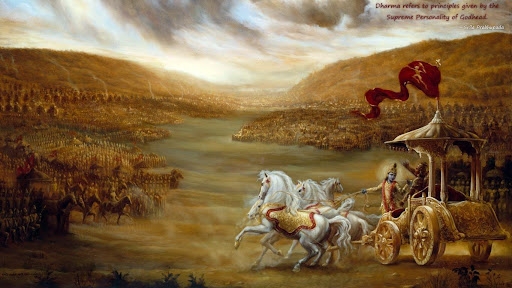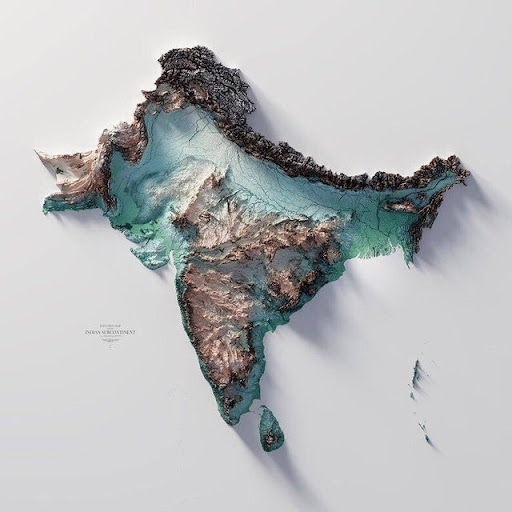India vs Bharat: यदा यदा हि धर्मस्य!
The India vs Bharat controversy started with the G-20 dinner invite of the President written with ‘President of Bharat’ and speculation of a name change of country in an upcoming special session of Parliament.
Total Views |
यदा यदा हि धर्मस्य ग्लानिर्भवति भारत।
अभ्युत्थानमधर्मस्य तदात्मानं सृजाम्यहम्॥
When I see this shloka, The radiance and power of this shloka resonates in me. This shloka gives me hope and ambition at the same time. I always feel that this shloka is the flagbearer of everything Indians are famous for- Commitment, hard work, and bouncing back from any lowest point.

This conversation starts with the G-20 dinner invite of the President written with ‘President of Bharat’ and speculation of a name change of country in an upcoming special session of Parliament.
So what is ‘Bharat’ and What is ‘India’?
Let’s talk about India, so in the simple sense, India is the land beyond Indus. Neighboring Arab countries and Iranians uttered 'h' and called this land Hindu. Ancient Greeks historians pronounced this name as Indus.
Sindhu is the name of the Indus River, mentioned in the Rig-Veda, one of the oldest Indo-European texts, created in the northern region of the Indian subcontinent between 1700-1100 BC. There are strong linguistic and cultural similarities of Rig-veda with the Iranian ‘Avesta’, which is often associated with the early culture of 2200-1600 BC of that region.
Megasthenes was an ancient Greek historian, diplomat, ethnographer and explorer in the Hellenistic period i.e. Golden Greek period. He wrote accounts about India in his book Indica. Megasthenes was then an ambassador for Seleucid king Seleucus I Nicator and to the court of the Mauryan Emperor Chandragupta Maurya in Pataliputra. The Indica book is now lost but there are many references from Indica that are given by later period historians and writers.
The English term is from Greek Ἰνδία (Indía), via Latin India. Iindía in Byzantine ethnography explains the region beyond the Indus River, since Herodotus alluded to "Indian land". Indos, "an Indian", from Avestan Hindus means Sindh and is listed as a conquered territory by Persian emperor Darius I (550-486 BC) in the Persepolis terrace inscription.
The name India was known in Old English (between at least the mid-5th century and the mid-12th century AD) and was used in King Alfred's translation of Orosius.
The name was replaced by Ynde or Inde due to French influence. It went into Early Modern English (the latter half of the 15th century to 1650 AD). The name India then came back to English usage from the 17th century onwards, maybe due to the influence of Latin, or Spanish or Portuguese.

When we start to track down the origins of ‘Bharat’, first we need to understand that, all the evidence is there in the ancient scriptures.
“Bharat” derives from India’s mythological understanding. This name is mentioned in the Mahabharata, India’s ‘etihas’. As per the epic. King Bharat, a legendary monarch, is said to have been the forebearer of all Indians. Thus, the name “Bharat” symbolizes a nation of King Bharat’s descendants.
Bharata is an illustrious king of Hindu literature. He belongs to the Chandravamsha dynasty, and with his continuous efforts and charisma, became the Chakravarti which means universal monarch. He is regarded to be the ancestor of the Pandavas, the Kauravas, Brihadratha, and Jarasandha. The legend of Bharata is mentioned in the Adi Parva of the Mahabharata, where he was depicted as the son of Dushyanta and Shakuntala.
There is another connotation, The Bharatas are a powerful Aryan clan alluded to in the Rigveda, Mandala 3 especially attributed to the Bharata sage Vishvamitra.
The entire Bharata clan is chronicled as crossing over, with their chariots and wagons, at the confluence of the Vipash (Beas River) and Shutudri (Sutlej).
The Bharatas are portrayed as the protagonists in the Battle of the Ten Kings in Mandala 7 (7.18 etc.), where they are on the winning side. They have been successful in the early power struggles between the various Aryan and non-Aryan clans so that they continue to dominate in post-Rig Vedic texts, and later in the (Epic) tradition.
There are many references in the Hindu scriptures about the word ‘Bharat’. For instance, In the Vishnu Purana, there is a shloka about the geographical description of Bharat. Which says,उत्तरं यत् समुद्रस्य हिमाद्रेश्चैव दक्षिणम् । वर्षं तद् भारतं नाम भारती यत्र सन्ततिः ।।” It means that Bharatam, or Bharat is the country that lies to the north of the ocean and to the south of the snowy mountains.
Some other Hindu texts also refer to Bharatvarsha as part of Jambudweep. Jambudweep means the island which was encased by oceans from three sides and which looks like Jamun fruit.
In the latest ebook by Sadhguru (Jaggi Vasudev), "Bha-ra-ta: The Rhythm of a Nation", he elaborated the science behind Bharat, India's original name.
In one of the interviews regarding his book, when he was questioned why "Bharat" matters, Sadhguru elaborated, "Bharat comes from bha – ra – ta. Bhava means sensation. Seeing, hearing, smelling, tasting, and touching are different types of sensations. Your whole experience of life is sensory right now. Bha means sensation, out of which emotion arises. Ra means raga or the tune. The tune is not yours – existence has already set it. Now you have to find the rhythm, which is the tala. If you find the right rhythm, you are a fantastic human being. If you miss the rhythm, you get crushed by the process of life."
So, For every Bharatiya, India is the identity given to them by other people like the Greeks and Romans. But, Bharat is their cultural, ethical, and emotional identity. For us, our culture, our traditions, and customs always matter most. This is the reason, on an international level, Indians are known for their upholding of culture and traditions.
On this matter, Our own guiding light, Our own Constitution gives us the correct answer, by stating in the first article “ India, that is Bharat”......
These four words simplify everything for me and my conscience. So , if anyone asks me, India or Bharat, I will always say- ‘India, that is Bharat’!!!!


